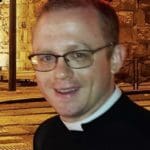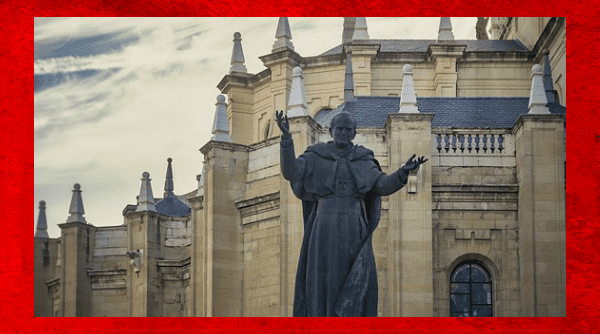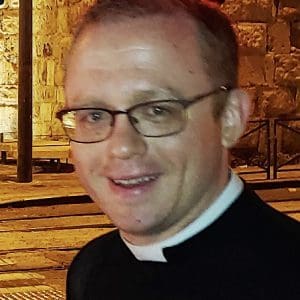The life and papacy of Saint John Paul II have had an immense impact on the Church after the Second Vatican Council and beyond. One only has to look at his contributions and personal witness through his theological and magisterial writings, his Marian and Eucharistic devotion, his opposition to atheistic communism, to his trips around the world for various events such as world youth days. In these areas and so many others, Saint John Paul II helped bring many souls the truth, freedom, and joy that faith in Jesus Christ through His church offers all nations in every age of history.
In recent weeks, there has been elevated criticism of Saint John Paul II for what is perceived by some people to be actions that enabled the predatory behavior and ascent of power of the former Cardinal Theodore McCarrick as Archbishop of Washington, DC. This criticism comes largely from the publication of the McCarrick Report in November, which highlights some details of John Paul II’s relationship to McCarrick’s rise of power and influence. Some commentators in the Church have questioned the prudence of the speed of his canonization. Other commentators have called outrightly to remove his feast from the Liturgical Calendar of the Church. In contrast, others have sought to defend his papacy against false allegations of his enablement of Cardinal McCarrick’s predatory rise to ecclesial power.
For such a conversation about John Paul II’s connections to Cardinal McCarrick, two questions ought to be asked. First, to what extent can human limitation/sin be accepted among those we dare call saints? Second, what are the actual intentions and reasons of those who wish to place a black mark against Saint John Paul II and even lobby to remove his feast from the liturgical calendar of the Church?
“Christ who lives in me”
The Second Vatican Council teaches us that the holiness of the Church “is unceasingly manifested, and must be manifested, in the fruits of grace which the Spirit produces in the faithful; it is expressed in many ways in individuals, who in their walk of life, tend toward the perfection of charity, thus causing the edification of others.”i The holiness of the lives of each of the saints is both “the fulness of the Christian life” and “the perfection of charity,” but it also manifests the presence of Christ in the life of the individual saint so much so that they have become one with Him.ii St. Paul speaks to us of this reality when he states to the Galatians “it is no longer I who live, but Christ who lives in me insofar as I now live in the flesh, I live by faith in the Son of God who has loved me and given himself up for me” (Gal 2:20). Pope Benedict XVI speaks of this reality of the saints when he stated:
…Whoever had and lived the faith in Christ Risen was called to become a point of reference for all others, setting them in this way in contact with the person and the message of Jesus, reveals the face of the living God. And this holds true also for us: a Christian who lets himself be guided and gradually shaped by the faith of the Church, in spite of his weaknesses, his limitations and his difficulties, becomes like a window open to the light of the living God, receiving this light and transmitting it to the world.iii
It is in this sanctity of life that all of the faithful in heaven and on earth manifest Jesus Christ uniquely in their own lives and persons. This manifestation of sanctity is not just rooted in natural moral greatness or human achievement but in surrender and cooperation with the grace of God given through the sacraments, prayer, and living out one’s vocation in the world. This fruitfulness that manifests the mystery of divine union with Jesus goes beyond the capacities of the individual believer, thus fulfilling Our Lord’s promise to His Apostles, “I am the vine, you are the branches. Whoever remains in me and I in him will bear much fruit, because without me you can do nothing” (Jn 15:5).
Each member of the Church, whether they be a saint in heaven or a saint still climbing the mountain of holiness on earth, is called to know, love, and serve God. Some of the saints are known for a specific strength in this regard, whether it is their zeal and love for the Lord and for souls, their contemplative or intellectual knowledge of the Lord, a combination of their knowledge and love of God and souls, or their service to the Lord through faithfulness to their daily duties of their state in life. There is also a need for each believer to be purified and liberated from sin. This need is at the heart of the call to conversion that brings about the sanctity of life that the Lord calls each of us to embrace that culminates with divine union. This call to conversion enables each believer to bear the fruit of grace that the Lord calls them to foster according to the particular vocation and mission he has entrusted to them in the life of faith.iv
Sinful saints and heroic virtue
But is every saint perfect in that they always did the will of God in everything in their life? Are canonized saints without mortal sin or personal failures? Are saints always fruitful in the way God intended them to be?
When we look at the saints and some of the significant figures of salvation history in Scripture, the apostles themselves, and the great saints of the history of the Church, we can see that the answer to these questions is “No”. Despite their sinfulness, the faithful witness of the saints, they also give encouragement and hope, highlighting that even our faults and sins can be paths of grace that lead us to conversion and union with Christ both on earth and in heaven.
One can see this, for example, in the case of St. Andrew Wouters, a diocesan priest in Gorkum, Netherlands. He was known for his public drunkenness, multiple affairs, and fathering multiple children despite his vow of celibacy. Calvinist raiders had taken over the town and started murdering priests and religious. According to some accounts, he chose to join them in their imprisonment, where he endured ridicule for his life of sinful debauchery, infidelity, and scandal at the hands of his Calvinist captors. On July 9, 1572, Fr. Andrew Wouters was executed alongside eighteen other priests and religious for being Catholic. As the noose was placed around his neck, he was asked by his captors if he would renounce his belief in the Eucharist and the papacy in order to save his life. Fr. Wouters final words to his captors were: “Fornicator I was, heretic I never was.” He would be canonized by Pope Bl. Pius IX, alongside the other martyrs of Gorkum, in 1865.v His faith and love for Christ exemplified in his act of martyrdom atoned for the sins of his earthly life to bring him by the grace of God to heavenly glory.
St. Robert Bellarmine reminds us that the Church honors the saints because they merited heroic virtue. “The saints are certain examples of virtues and norms of right living, and, as it were, a certain lamp enkindled before God so that they would give light to all others.”vi An act of canonization is known as a dogmatic fact because the authority of the Church states with absolute certainty that the person canonized died in a state of grace, is in heaven, and exemplified heroic virtue in their life of faith on earth.vii
Yet outside the case of Our Lady, who is without sin,viii heroic virtue in the cases of all other saints should not be confused with perfect heroic virtue nor the divine virtue that is proper to God alone. This witness of heroic virtue does not mean every saint always did the will of God, is without sin, or is always fruitful in the life of grace in all that they did. Imagine if St. Andrew Wouters lived out his priestly vows more faithfully and took advantage of the graces that he was given early on through his ordination and the sacramental life of the Church? What else could he have done if he was more faithful to the graces that he was given but squandered in his early life?
Such an insight into the limits of saints is not to sweep sin, such as clerical sexual abuse, under the rug. It is to realize that each saint bears a light, but also struggles with the realities of the Fall. God can use the light of the holiness of the Saints to compensate for what each other lacks and to help sanctify each other. In this bond of sanctity established through faith, hope, and love that the Lord brings about his Kingdom.
Questionable motivations
As horrible as the sin of clerical sexual abuse is, the call Catholic figures and by some news outlets to suppress devotion to John Paul II and to place the blame of the McCarrick scandal at his feet may have ulterior motives. The loudest cries for “justice” in suppressing his cult come from figures and outlets who openly sought to undermine both the magisterium of John Paul II and change the constant teaching of the Church to suit their own theological preferences and agendas. Such calls are not only dishonest but spit in the face of Our Lord, as well as John Paul II, and do a serious disservice to the efforts to bring healing to victims of clerical sexual abuse. They reek of dishonesty, arrogance, and promotion of heresy masked under the guise of supposed pastoral sensitivity, justice, and compassion of abuse victims.
It also hides the fact of their own personal collaboration with Cardinal McCarrick to promote various progressive and heterodox agendas. Instead of bringing healing, they bring division, chaos, and new wounds through both ideological warfare and “selective” prosecution of the errors of “some” and not “all” who are involved with the McCarrick affair.
Not all who question the prudence of John Paul II’s canonization do so maliciously. Some raise legitimate points of question on prudential judgments he made through wrong information, personal weakness, error, or shortcomings. Some of these questions may involve some of the episcopal appointments that he made, specific pastoral strategies, or inactions that perhaps bore a negative effect upon the Church. To question the actions of the pontificate of Saint John Paul II is not to denigrate his sanctity or the heroic virtue he did through the grace of God. Such questions seek to have an honest look at the person and legacy which impacted the present day.ix
Nevertheless, these questions have to be raised in a spirit of truth and esteem for the Church, whose process of canonization leaves no stone unturned in the careful assessment of candidates for sainthood. A discovery of new information casting a shadow on John Paul’s legacy of leadership can still help us to recognize the real dynamic and tension between personal virtue and occupational success. If anything, the McCarrick Report underscores the incompleteness or sometimes lack of information that was at the Holy Father’s disposal. Such a lack of prudential judgments in no way compromises the integrity or value of his papal magisterium.x Furthermore, we learned that the late Pope was quite familiar with the destructive nature of smear narratives having witnessed such campaigns launched against the Church’s leaders, by the atheistic Communists of his native Poland.
Conclusion
It is crucial for the Church to foster a healthy and realistic devotion to saints, with an awareness of historical context and a frank admission that every child of Adam struggles against weakness, ignorance, and sin. Where certain saints have limits and failures, other saints can show great heroic strength, knowledge, and confidence that make up for the weaknesses and afflictions in the members of the body of Christ (cf. Col 1:24). Such a realization is not only at the heart of the union of the Communion of Saints that is the Church Triumphant in heaven but also its union with the members of the Communion of Saints that is Church Militant on earth and the Church Suffering in purgatory. It shows that our salvation is not just individual achievement but rooted in the familial love of faith that is the bond that unites earth to heaven and the saints of God, no matter where they may be on the journey of faith, to the love of God manifested in Christ Jesus (cf. 1 Jn 4:9).
Endnotes:
i Lumen Gentium 39; CCC 688.
iii Benedict XVI, “The Faith of the Church”; General Audience (October 31, 2012).
iv Reginald Garrigou Lagrange, “Our Participation in the Mysteries of Our Lord’s Life,” Our Savior and His Love for Us, (Rockford, IL: TAN Books & Publishers, Inc, 1998) 341-350; Pope Francis, Gaudete et Exultate: Apostolic Exhortation on the Call to Holiness in Today’s World (March 19, 2018), 25-34.
v Charles Johnson, “Father Andrew Wouters: ‘Fornicator I was, Heretic I never was.”Nowthatiamcatholic.com (12-27-2020).
vi Robert Bellarmine, On the Canonization and Veneration of the Saints, (Mediatrix Press, 2019. Kindle Edition). Chapter VII
vii Ibid Ch VII & VIII; John Paul II, Ad Tuendam Fidem, Motu Proprio (May 18, 1998); Congregation of the Doctrine of the Faith, Doctrinal Commentary on the Concluding Formula of the Professio Fidei (June 29, 1998), 11.
viii CCC 966-971.
ix See especially Gaudete et Exultate, 169-175.
x As Catholics we believe that when the Holy Father teaches the faith in proper stewardship and cooperation with graces of His office, he cannot err. See further CCC-880-892; Lumen Gentium, 22-26; and Pastor Aeternus, Ch 3-4.




